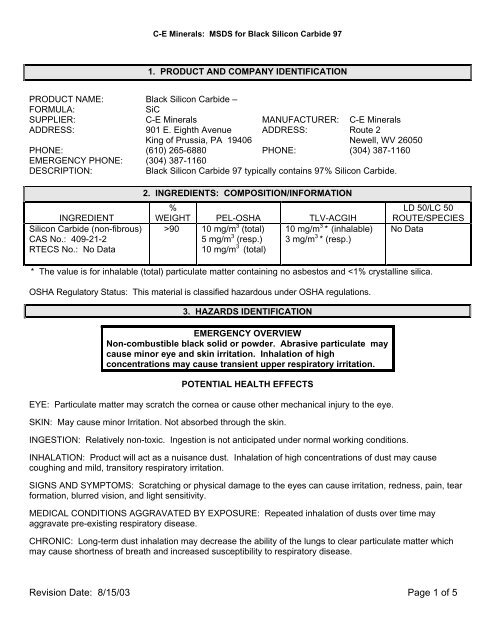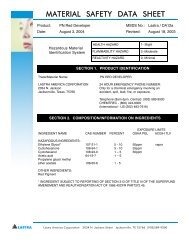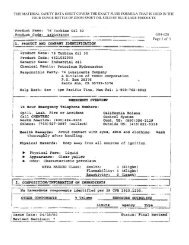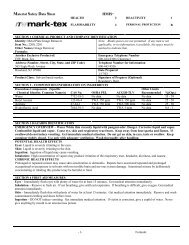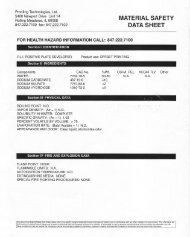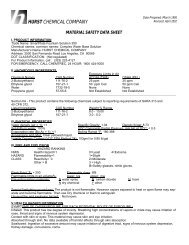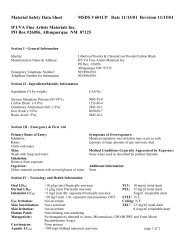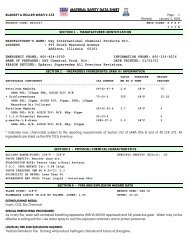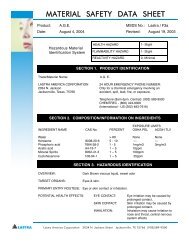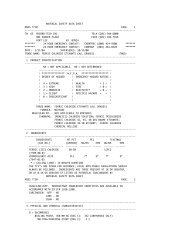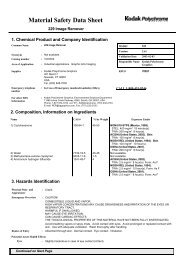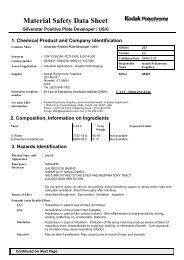Carborundum Grit MSDS - Takach Press
Carborundum Grit MSDS - Takach Press
Carborundum Grit MSDS - Takach Press
You also want an ePaper? Increase the reach of your titles
YUMPU automatically turns print PDFs into web optimized ePapers that Google loves.
C-E Minerals: <strong>MSDS</strong> for Black Silicon Carbide 97<br />
1. PRODUCT AND COMPANY IDENTIFICATION<br />
PRODUCT NAME: Black Silicon Carbide –<br />
FORMULA:<br />
SiC<br />
SUPPLIER: C-E Minerals MANUFACTURER: C-E Minerals<br />
ADDRESS: 901 E. Eighth Avenue ADDRESS: Route 2<br />
King of Prussia, PA 19406 Newell, WV 26050<br />
PHONE: (610) 265-6880 PHONE: (304) 387-1160<br />
EMERGENCY PHONE: (304) 387-1160<br />
DESCRIPTION:<br />
Black Silicon Carbide 97 typically contains 97% Silicon Carbide.<br />
INGREDIENT<br />
Silicon Carbide (non-fibrous)<br />
CAS No.: 409-21-2<br />
RTECS No.: No Data<br />
2. INGREDIENTS: COMPOSITION/INFORMATION<br />
%<br />
WEIGHT PEL-OSHA TLV-ACGIH<br />
>90 10 mg/m 3 (total) 10 mg/m 3 * (inhalable)<br />
5 mg/m 3 (resp.) 3 mg/m 3 * (resp.)<br />
10 mg/m 3 (total)<br />
LD 50/LC 50<br />
ROUTE/SPECIES<br />
No Data<br />
* The value is for inhalable (total) particulate matter containing no asbestos and
C-E Minerals: <strong>MSDS</strong> for Black Silicon Carbide 97<br />
POTENTIAL HEALTH EFFECTS (continued)<br />
TARGET ORGAN: Lungs<br />
CARCINOGENICITY: NTP: No IARC: No OSHA: No<br />
4. FIRST AID MEASURES<br />
EYE: Flush eyes with lukewarm water for 15 minutes opening and closing eyelids to ensure adequate rinsing.<br />
If redness, irritation, pain, or tearing occurs, seek medical attention.<br />
SKIN: Wash area with soap and water. Wash contaminated clothing. Seek medical attention if symptoms<br />
occur.<br />
INHALATION: Not expected. If inhalation of high concentrations occurs, remove to fresh air. A certified<br />
professional should administer oxygen or CPR if indicated. Seek immediate medical attention.<br />
INGESTION: None required for small amounts. If large amounts are ingested, seek medical attention.<br />
5. FIRE FIGHTING MEASURES<br />
FLAMMABLE PROPERTIES<br />
FLASH POINT:<br />
Not Applicable<br />
FLAMMABLE LIMITS: LEL: Not Applicable UEL: Not Applicable<br />
NFPA CLASSIFICATION:<br />
HEALTH: 0 FLAMMABILITY: 0 INSTABILITY: 0<br />
EXTINGUISHING MEDIA: Any. Use media appropriate for surrounding fire.<br />
FIRE AND EXPLOSION HAZARDS: Non-flammable, non-combustible. Product will not burn.<br />
HAZARDOUS DECOMPOSITION PRODUCTS: None<br />
FIRE FIGHTING INSTRUCTIONS: Firefighters should wear a NIOSH approved full-facepiece self-contained<br />
breathing apparatus (SCBA) operated in positive pressure mode and full turnout or bunker gear.<br />
6. ACCIDENTAL RELEASE MEASURES<br />
Isolate hazard area and deny entry to unauthorized and/or unprotected personnel. Vacuum small amounts.<br />
Gently shovel or scoop large amounts into clean dry container for later recycle or disposal. Water mist may be<br />
added as necessary to control the level of airborne dusts. Wear appropriate protective equipment (See<br />
Section 8).<br />
Revision Date: 8/15/03 Page 2 of 5
C-E Minerals: <strong>MSDS</strong> for Black Silicon Carbide 97<br />
7. HANDLING AND STORAGE<br />
Store in dry area in closed containers. Storage and work areas should be periodically cleaned to minimize<br />
dust accumulation. Avoid dust inhalation and promulgation. DO NOT use compressed air or dry sweeping to<br />
remove dust from work area. Dusts should be removed using an appropriately equipped vacuum. If a vacuum<br />
is unavailable, only wet-clean-up methods should be used (i.e. wet sweeping, misting, etc.). Moisture should<br />
be added as necessary to reduce exposure to airborne respirable dust.<br />
Under dusty conditions, employees should wear coveralls or other suitable work clothing. Vacuum grossly<br />
contaminated clothing before removal. Practice good housekeeping. Wash thoroughly after handling.<br />
Change contaminated clothing. Do not reuse until laundered.<br />
8. EXPOSURE CONTROLS/PERSONAL PROTECTION<br />
RESPIRATORY: Under normal working conditions, below acceptable exposure guidelines, none is required.<br />
For concentrations to 10X above the PEL, a NIOSH/MSHA approved dust mist respirator should be worn.<br />
Appropriate respirator selection will be dependent upon the magnitude of exposure and must be selected in<br />
accordance with 29 CFR 1910.134.<br />
SKIN: Protective gloves, as necessary to prevent irritation.<br />
EYES: Safety-glasses with side shields or goggles to prevent dust and particles from entering the eye.<br />
ENGINEERING CONTROLS: General ventilation. Local exhaust may be necessary for processes which<br />
generate large quantities of airborne dust.<br />
OTHER: None<br />
9. PHYSICAL AND CHEMICAL PROPERTIES<br />
APPEARANCE:<br />
Black solid or powder.<br />
ODOR:<br />
Odorless<br />
SOLUBILITY IN WATER:<br />
Insoluble<br />
SPECIFIC GRAVITY (H 2 O = 1): 3.21<br />
MELTING POINT: SiC does not melt but dissociates at –2300 C.<br />
pH (10% slurry):<br />
Not Applicable<br />
% VOLATILE 0<br />
TYPES:<br />
Sizes range from coarse to powder<br />
10. STABILITY AND REACTIVITY<br />
STABILITY: Stable under normal ambient conditions of temperature and pressure.<br />
REACTIVITY/INCOMPATIBILITY: None known.<br />
Revision Date: 8/15/03 Page 3 of 5
C-E Minerals: <strong>MSDS</strong> for Black Silicon Carbide 97<br />
10. STABILITY AND REACTIVITY (continued)<br />
DECOMPOSITION PRODUCTS: Not Applicable<br />
HAZARDOUS POLYMERIZATION: Will not occur.<br />
11. TOXICOLOGICAL INFORMATION<br />
EYE: Particulate matter may cause physical injury to the eye.<br />
SKIN: May cause minor skin irritation.<br />
INHALATION: May cause minor transient respiratory irritation.<br />
INGESTION: None known.<br />
CHRONIC: Physiologic consequence of particulate overload of the respiratory tract involves altered<br />
macrophage function, sequestration of particles and increased lung burden. When large numbers of particles<br />
reach the interstitium, interstitial macrophage-fibroblast interactions are stimulated which in turn can stimulate<br />
fibrosis. Once overloaded, the macrophages can also become sequestrian compartments. As dust<br />
concentrations within the lung increase, the retention half-life for particulate matter also increases.<br />
SUBCHRONIC: No Data<br />
OTHER: None known<br />
12. ECOLOGICAL INFORMATION<br />
Black Silicon Carbide does not contain ozone depleting substances. It is not expected to exert an ecotoxic<br />
effect or bioconcentrate in the food chain.<br />
13. DISPOSAL CONSIDERATIONS<br />
Dispose of according to applicable federal, state, and local regulations. Dispose per 40 CFR 261 and 262.<br />
14. TRANSPORT INFORMATION<br />
U.S. Department of Transportation (DOT): Not Classified<br />
15. REGULATORY INFORMATION<br />
CANADIAN WHMIS: Not classified<br />
EPCRA Section 302 (EHSs): This product does not contain ingredients subject to reporting requirements of 40<br />
CFR Part 355, Appendices A and B (Extremely Hazardous Substances).<br />
Revision Date: 8/15/03 Page 4 of 5
C-E Minerals: <strong>MSDS</strong> for Black Silicon Carbide 97<br />
15. REGULATORY INFORMATION (continued)<br />
CERCLA, Section 304: This product does not contain ingredients subject to state and local reporting under<br />
Section 304 of SARA Title III as listed in 40 CFR Part 302, Table 302.4<br />
SARA 313 REPORTING REQUIREMENTS: This product does not contain ingredients subject to the reporting<br />
requirements of Section 313 SARA, and Section 6607 of the Pollution Prevention Act:<br />
SARA HAZARD CATEGORY: This product has been reviewed according to the EPA Hazard Categories<br />
promulgated under Sections 311 and 312 of the Superfund Amendment and Reauthorization Act of 1986<br />
(SARA Title III) and by definition, does not meet the requirements of any category.<br />
16. OTHER INFORMATION<br />
Revision Date:<br />
5/4/99 C-E Minerals purchased former producer<br />
8/27/01 updated manufacturing facility location.<br />
8/15/03 Health and safety review and update<br />
KEY:<br />
ACGIH:<br />
CAS:<br />
(C):<br />
DOT:<br />
IARC:<br />
MSHA:<br />
NFPA:<br />
NIOSH:<br />
NTP:<br />
OSHA:<br />
PEL:<br />
SARA:<br />
TLV:<br />
American Conference of Governmental Industrial Hygienists<br />
Chemical Abstracts Service<br />
Ceiling Limit<br />
Department of Transportation<br />
International Agency for Research on Cancer<br />
Mine Safety and Health Administration<br />
National Fire Protection Association<br />
National Institute for Occupational Safety and Health<br />
National Toxicology Program<br />
Occupational Safety and Health Administration<br />
Permissible Exposure Limit<br />
Superfund Amendment and Reauthorization Act<br />
Threshold Limit Value<br />
DISCLAIMER<br />
Although reasonable care has been taken in the<br />
preparation of the information contained herein,<br />
C-E Minerals extends no warranties, makes no<br />
representation and assumes no responsibility as to<br />
the accuracy of suitability of such information for<br />
application to purchaser’s intended purposes or for<br />
consequences of its use.<br />
Revision Date: 8/15/03 Page 5 of 5


